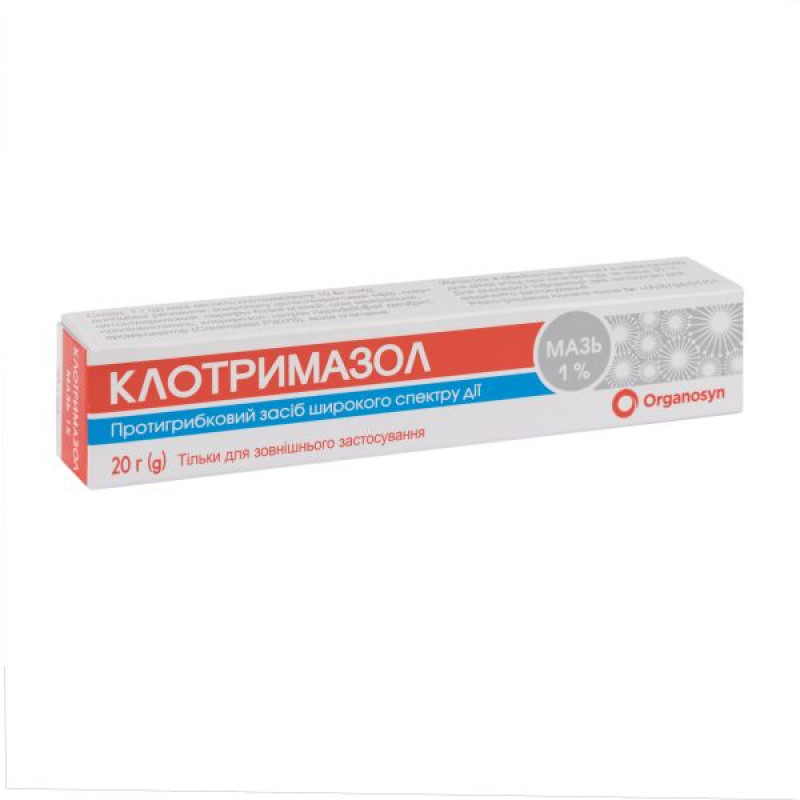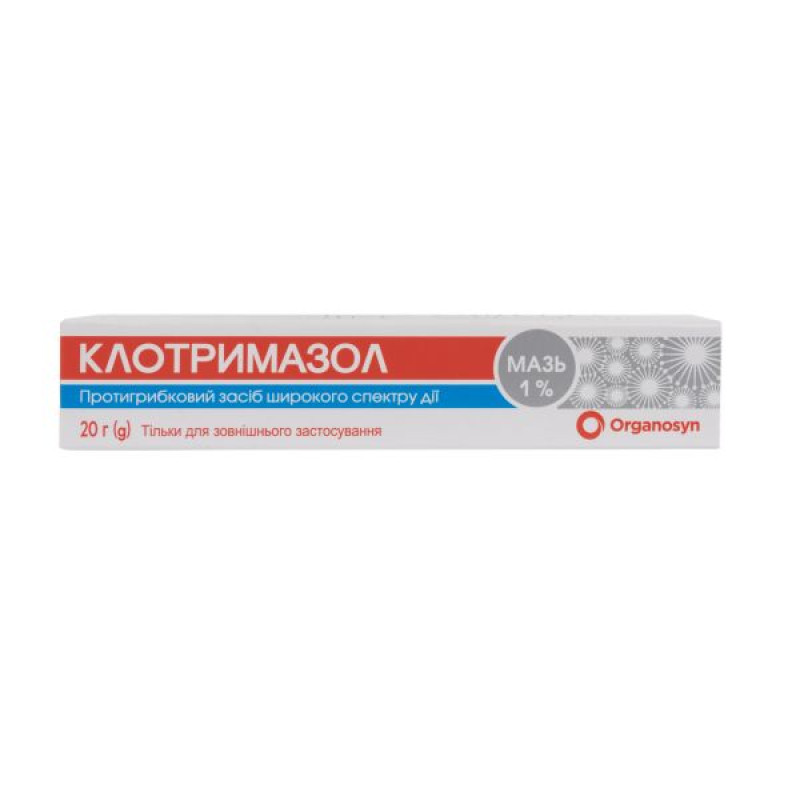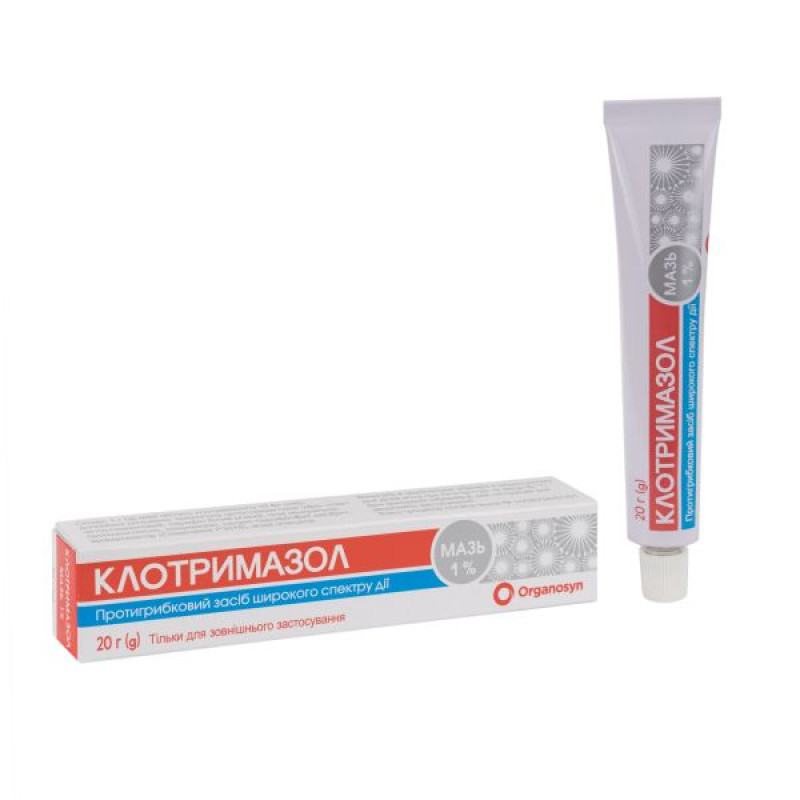Clotrimazole ointment 1% tube 20 g

Instructions Clotrimazole ointment 1% tube 20 g
Composition
active ingredient: clotrimazole;
1 g of ointment contains clotrimazole 10 mg;
excipients: macrogol cetostearyl ether, cetostearyl alcohol, white soft paraffin, mineral oil, propylene glycol, chlorocresol, sodium hydrogen phosphate dihydrate, flavoring (Creamatest P3078), purified water.
Dosage form
Ointment.
Main physicochemical properties: soft white ointment.
Pharmacotherapeutic group
Antifungal drugs for topical use. Imidazole and triazole derivatives. Clotrimazole. ATX code D01A C01.
Pharmacological properties
Pharmacodynamics
Clotrimazole has a broad spectrum of antifungal activity in vitro and in vivo, including against dermatophytes, blastomycetes, hyphomycetes, and dimorphic fungi.
In experimental studies, the minimum concentrations that inhibit the development of fungi were 0.062-4 (-8) μg/ml. Clotrimazole has a predominantly fungistatic effect. In vitro effects are limited to the action on proliferating fungal elements; fungal spores have low vulnerability. The mechanism of action is to inhibit the synthesis of ergosterol, which leads to the destruction and deterioration of the function of the cytoplasmic membrane of the fungus.
In addition to its antifungal effect, clotrimazole in vitro inhibits the growth of corynebacteria and gram-positive cocci, with the exception of enterococci, at concentrations of 0.5-10 μg/ml and acts on Trichomonas at a concentration of 100 μg/ml.
Resistance to clotrimazole is considered favorable in primary resistant strains of susceptible fungal species and occurs rarely. Secondary resistance develops in primary susceptible fungal species after treatment, which is observed extremely rarely.
Pharmacokinetics
Pharmacokinetic studies have shown that the absorption of clotrimazole is insignificant - < 2 and 3-10% of the applied dose with a peak plasma concentration of the active substance < 10 ng/ml.
Indication
Fungal infections of the skin and mucous membranes caused by dermatophytes, yeasts and molds and other pathogens sensitive to clotrimazole.
Skin infections caused by Malassezia furfur (tinea) and Corynebacterium minutissimum (erythrasma).
Candidal vulvitis and candidal balanitis.
Contraindication
Hypersensitivity to clotrimazole or to any other components of the drug.
Interaction with other medicinal products and other types of interactions
There are no known cases of interaction with other drugs. Due to low absorption with topical application, the risk of interactions is unlikely.
When Clotrimazole ointment is used simultaneously with latex products (e.g. condoms and diaphragms), the functional ability of the latter may be reduced due to excipients contained in the drug (especially stearates), which, as a result, may affect the safety of these products.
Application features
The medicinal product contains cetostearyl alcohol and propylene glycol, which may cause local skin reactions (e.g. contact dermatitis) and skin irritation, as well as chlorocresol, which may cause allergic reactions. In such cases, it is recommended to use dosage forms that do not contain this component (solution or spray) instead of the cream.
This medicine contains benzyl alcohol and should not be used in premature babies and newborns.
During the use of this drug, sexual contact should be avoided, as the infection may be transmitted to the partner. When using Clotrimazole, ointment, simultaneously with latex products (for example, condoms and diaphragms), the functional ability of the latter may be reduced due to excipients contained in Clotrimazole, ointment (especially stearates), which, as a result, may affect the safety of these products. This effect is temporary and is observed only during the period of use of the drug. Avoid contact with eyes. Do not swallow.
The patient is advised to consult a doctor: if hypersensitivity to any antifungal agents or imidazole derivatives is detected; if there is a history of venereal diseases in the patient or his sexual partner; if the patient has a high body temperature (38 °C or higher), pain in the lower abdomen, dysuria, back pain, purulent vaginal discharge with an unpleasant odor, vulvar and vaginal ulcers, redness, diarrhea, nausea, vomiting, vaginal bleeding accompanied by shoulder pain.
Warnings regarding the treatment of candidal vulvitis in women. Treatment should not be performed during menstruation. Treatment should be completed before the onset of menstruation.
Do not use tampons, intravaginal irrigations, spermicides, or other vaginal products while using this medication.
Ability to influence reaction speed when driving vehicles or other mechanisms
Does not affect.
Use during pregnancy or breastfeeding
There are limited studies on the use of clotrimazole during pregnancy. Animal studies do not indicate direct or indirect harmful effects with respect to reproductive toxicity. As a precautionary measure, it is preferable to avoid the use of clotrimazole during the first trimester of pregnancy.
Breastfeeding should be discontinued during treatment with Clotrimazole. Do not apply Clotrimazole ointment to the mammary glands during the entire period of breastfeeding.
Method of administration and doses
Adults should apply the ointment 1-3 times a day. Apply a 0.5 cm strip of ointment in a thin layer to an area of skin the size of the palm of your hand and rub in.
For candidal vulvitis and candidal balanitis in adults, apply a thin layer of ointment to the affected areas (external genitals and perineum in women or glans penis and foreskin in men) and rub in. Therapy of these diseases requires simultaneous treatment of both partners.
For reliable removal of the pathogen and depending on the symptoms, treatment should be continued for approximately 2 weeks after the disappearance of subjective symptoms.
The total duration of treatment is:
dermatomycoses – 3-4 weeks; erythrasma – 2-4 weeks; lichen planus – 1-3 weeks; candidal vulvitis and candidal balanitis – 1-2 weeks.
The patient must inform the doctor if there is no improvement after 4 weeks of treatment.
Children
There is no experience with the use of the drug in children.
Overdose
There is no risk of acute intoxication, as overdose is unlikely to occur after a single vaginal dose or cutaneous application (application to large areas of skin under conditions conducive to increased absorption), or after accidental oral administration. There is no specific antidote.
In the event of accidental oral ingestion, gastric lavage may rarely be necessary if a life-threatening dose has been taken within the previous hour or if there are visible symptoms of overdose (e.g. dizziness, nausea or vomiting). Gastric lavage should only be performed if adequate respiratory protection is available.
Adverse reactions
During the use of the drug, the following side effects are possible:
Immune system: allergic reactions (fainting, hypotension, shortness of breath, urticaria); Skin and subcutaneous tissue: redness (erythema), blisters, malaise, discomfort/pain, swelling, irritation, peeling, itching, rash, tingling, burning/heat sensation.
Expiration date
4 years.
Storage conditions
Store in the original packaging out of the reach of children at a temperature not exceeding 30 °C.
Packaging
20 g in an aluminum tube in a cardboard pack.
Vacation category
Without a prescription.
Producer
Encube Ethicals Private Limited.
Location of the manufacturer and its business address
Plot No. C-1, Madkaim Industrial Estate, Madkaim, Post Mardol, Ponda, Goa – 403 404, India.
There are no reviews for this product.
There are no reviews for this product, be the first to leave your review.
No questions about this product, be the first and ask your question.





